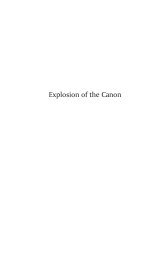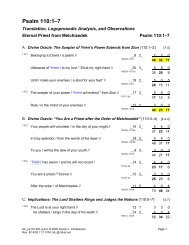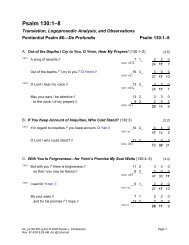Reading Genesis 1-2 in Hebrew - Bibal.Net
Reading Genesis 1-2 in Hebrew - Bibal.Net
Reading Genesis 1-2 in Hebrew - Bibal.Net
You also want an ePaper? Increase the reach of your titles
YUMPU automatically turns print PDFs into web optimized ePapers that Google loves.
<strong>Read<strong>in</strong>g</strong> <strong>Genesis</strong> 1–2 <strong>in</strong> <strong>Hebrew</strong><br />
cannot be doubled, which results <strong>in</strong> compensatory lengthen<strong>in</strong>g of the vowel <strong>in</strong> the def<strong>in</strong>ite article<br />
from —ñ a (Pa¥tax) to ”ñ A (qAmAc) and “vowel harmonization” <strong>in</strong> the change of the “e” vowel <strong>in</strong> the<br />
noun ’r’' to an “a” vowel <strong>in</strong> ’rA'Ah. The so-called gutturals ', h, x, v and also r cause many<br />
seem<strong>in</strong>gly irregularities <strong>in</strong> the forms of words <strong>in</strong> <strong>Hebrew</strong>.<br />
�������û���π‘�������„��������������������û��������������������1:2�<br />
������Œ����û��π‘�������„<br />
���������������������������<br />
����������������û�������������������—transliteration:<br />
w¸-hA-'Aµ-rec hA-y¸-t‰µ tO-µh˚ wA-bO-µh˚, “and the earth<br />
was formless and void.” The fem. noun eree' (“earth”) has two prefixes: the wau-conjunction and<br />
the def<strong>in</strong>ite articleñAh. Note the diamond-shaped accent rebÓav on the word �����������,<br />
which carries<br />
a relatively strong disjunctive force. The f<strong>in</strong>al syllable <strong>in</strong> the word hA-'Aµ-rec is a closed<br />
unaccented syllable. A closed syllable ends with a consonant whereas an open syllable ends<br />
with a vowel. The verbal form hAt¯yAh is Qal 3 rd sg. fem. from the root hƒyAh (“be[come]”). Note that<br />
each syllable here is open: hA-y¸-tAµh, because h at the end of a word, except when that h<br />
constitutes the f<strong>in</strong>al root letter, is normally a vowel letter and thus silent, and often transliterated<br />
as ‰. For our purposes here, we are follow<strong>in</strong>g the practice of Thomas Lambd<strong>in</strong> (Introduction to<br />
Biblical <strong>Hebrew</strong>. New York: Charles Scribner’s Sons, 1971) by <strong>in</strong>dicat<strong>in</strong>g all occurrences of the<br />
<strong>Hebrew</strong> letter h with h, <strong>in</strong> the <strong>Hebrew</strong> text we are study<strong>in</strong>g. Other vowel letters <strong>in</strong>clude w and y.<br />
Note that the div<strong>in</strong>e name hwhy is made up entirely of these three vowel letters. The masc.<br />
nouns ˚hKät (“formlessness, empt<strong>in</strong>ess”) and ˚h–»bµ (“empt<strong>in</strong>ess”) appear together here as an idiom<br />
to designate primeval chaos. Before an open syllable both of these words lose their daghesh<br />
and are pronounced with the spirantized t and b accord<strong>in</strong>gly.<br />
�������û���π‘�������„���—transliteration: w¸-xOµ-Hek val-P¸-n t¸hÙµm, µ “and darkness was on the face<br />
of the Deep.” The masc. noun eHäx (“darkness”) is the subject <strong>in</strong> a noun clause <strong>in</strong> which the<br />
verb “to be” is understood. Note that the dot above the second consonant <strong>in</strong> the word eHx<br />
(“darkness”) fills two roles simultaneously—as the vowel ◊ñO (xÙlAm) and the dot that<br />
dist<strong>in</strong>guishes W from H. The ږ <strong>in</strong> must be written <strong>in</strong> the f<strong>in</strong>al KAp, but it has no sound. The<br />
preposition -lav (“upon”) is connected to the masc. noun hƒnLAp (“face”) with the mean<strong>in</strong>g “on the<br />
face of.” The <strong>Hebrew</strong> is plural: faces-of abyss, not faces of-abyss; that is, the first of two words<br />
<strong>in</strong> the genitive relation suffers change; not the second, as <strong>in</strong> Lat<strong>in</strong> or Greek.<br />
The y after ‘ñ <strong>in</strong> yEn¯Lp (“face of”) is silent, as is the y after ÷ñ <strong>in</strong> £yih»l¤' ('È-lO-hÓµm). When a f<strong>in</strong>al<br />
stressed syllable is closed, it will have a long vowel as <strong>in</strong> the word t¸hÙµm. The fem. noun £ÙhK¯t<br />
(“deep, abyss”) is closely related to the name of the goddess Tiamat, who plays an important<br />
role <strong>in</strong> the creation myth of ancient Mesopotamia. The w is silent under ≤ñ or with a dot <strong>in</strong> it ˚.<br />
������Œ����û��π‘�������„<br />
�����������������������—transliteration:<br />
w¸-r˚µ-ax 'È-lO-hÓµm m¸-ra-xeµ-pet<br />
val-P¸-n ham-mAµ-yim, µ “and the spirit of Elohim was hover<strong>in</strong>g on the face of the waters.” The<br />
wau-conjunction w (“and”), which is affixed to a noun, is normally written with shewa. The verbal<br />
© 2005 BIBAL Corporation, All Rights Reserved Version 1.0<br />
2





